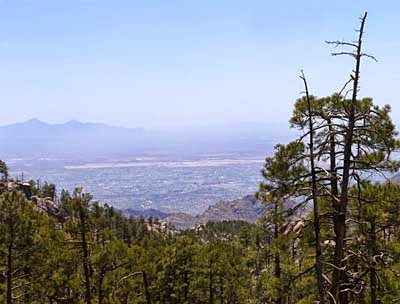 |
| The saguaro, monarch of the Sonoran Desert |
As much as we would have liked to linger in the mountains
of the Gila, we needed to keep moving west if we were to see those desert parks
before the heat began in earnest. It
wasn’t a long journey to Tucson but the wind and dust started blowing not long
out of Silver City. Instead of three
hours it took closer to four and David was very glad to arrive in Tucson and
rest his arms – fighting wind while driving the RV is not a lot of fun.
 |
| Prickly pear 'toes' or blooms |
The next day we were rested and ready to see some big
cactus. But first, a Mexican breakfast
at Teresa’s Mosaic Café where all the tables are made of mosaic tile and the
breakfast is big. We stuffed ourselves
with huevos rancheros and eggs with enchiladas then headed for Saguaro National
Park.
 |
| Mexican breakfast on a mosaic table, yum! |
The park has two sections, one on the east side of Tucson
and the other on the west separated by the city. Our plan was to visit Saguaro East that
morning and visit Saguaro West late in the day and stay through sunset. Both sides of the park were equally
interesting and beautiful. Since it was
warm and we had Maya with us, we only walked a few short nature trails. But we enjoyed that very much and learned a
lot about the saguaro and other plants and animals of the Sonoran Desert.
 |
| Young saguaro forest |
 |
| Mature saguaro forest |
A saguaro has shallow roots that can stretch out in every
direction for as long as the cactus is tall.
During one rainfall these shallow roots can soak up as much as 200 gallons
of water, enough to last the cactus for a year. Saguaros live around 150 years and don’t even
start to bloom until they are about 30 years old. At 75 years a saguaro may sprout its first
branches, or arms. By 100 it might reach
25 feet. Saguaros that live 150 years or
more attain grand sizes, towering as much as 50 feet and dwarfing every other
living thing in the desert. Many birds
and mammals live in or around the saguaro sheltering inside the cactus or cooling
in its shade.
Saguaro Blooms
The area around Tucson used to have very thick forests of
saguaros but some of these forests have declined. Livestock grazing made it almost impossible
for regeneration by either trampling the new seedlings or by compacting the
soil and killing the nurse plants that protected the seedlings. Today with grazing eliminated thousands of
young saguaros have taken hold and are thriving. But natural forces of freezing weather, fire,
invasive species and human forces such as vandalism and cactus poaching still
take a toll on the saguaro forests.
 |
| Saguaro near sunset |
 |
| Sunset |
After a full day of experiencing the desert we decided to
take the Sky Island Scenic Byway from Tucson about 30 miles up into the Santa
Catalina Mountains to the top of Mt. Lemmon. This highway starts in the Sonoran
Desert life zone and winds its way through 5 life zones ending in a mixed
conifer forest near the top of Mt. Lemmon.
It is an amazing drive snaking its way up the side of the mountains
through saguaros all the way to aspens.
 |
| Leaving the Sonoran Desert behind |
 |
| Near the top of Mt. Lemmon looking out at Tucson and the Sonoran Desert |
Contained within the Santa Catalina Mountains is the
Pusch Ridge Wilderness where we decide a hike in pine trees and aspen was just
what we needed. We hiked the Marshall
Gulch Trail and then made a loop out of it by hiking back down the Aspen
Trail. It was almost cold as we were
near 8,000 feet. What a nice change from
the desert!
 |
| Thimble Peak |
The two trails we hiked led through a section of the
forest that had a fire in 2003. It was
interesting to see the area after a little more than 10 years recovery. The new ponderosa pines were nearly 4 feet
tall and the faster growing aspens were 15 feet and taller.
 |
David and Maya hiking through young ponderosa pines
with mature ponderosa forest behind |
This was the first time in over a year that we have been
as high 8,000 feet and we felt it. After
all that exertion we thought we deserved a reward so we allowed ourselves to
split a huge chocolate chip cookie at the Cookie Cabin in the little village of
Summerhaven near the trailhead. It was
the biggest and most buttery cookie I have ever seen or tasted. The calorie burn of the hike and the calorie intake
of the cookie was probably a net zero.
 |
| Taking a well deserved rest |
Tucson is a place of contrasts – all that nature from
desert to pine forests with five mountain ranges surrounding it. We could have stayed much longer as there were many more places to explore and we didn't do any 'city stuff.' But we were due in Phoenix for a rendezvous with my cousin and a trip to Young, AZ. And the desert was getting warm. March and early April may be the best times to see the desert in bloom and not wilt in the heat.
David's Stats:
Days Hiked 2
Total Miles Hiked 6.26
Ave. Miles per Day
3.13
Total Elevation Gain 1,143
Ave. Elevation Gain per day 572















No comments:
Post a Comment